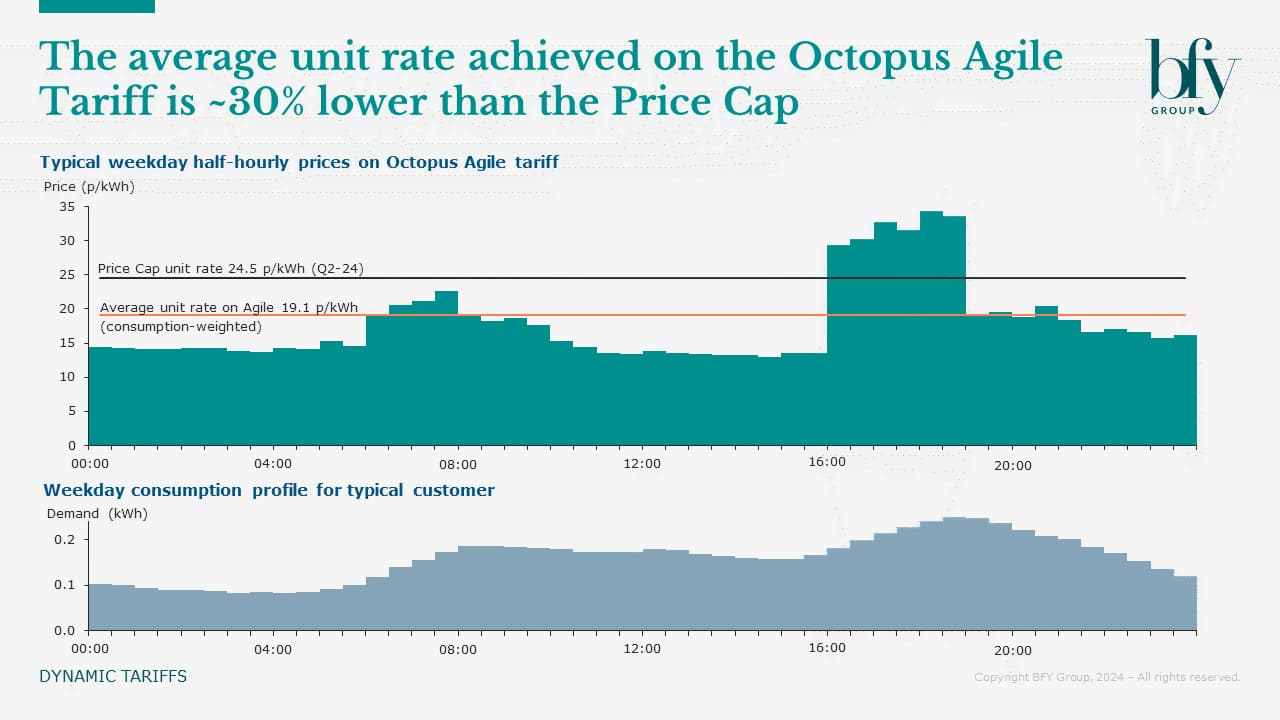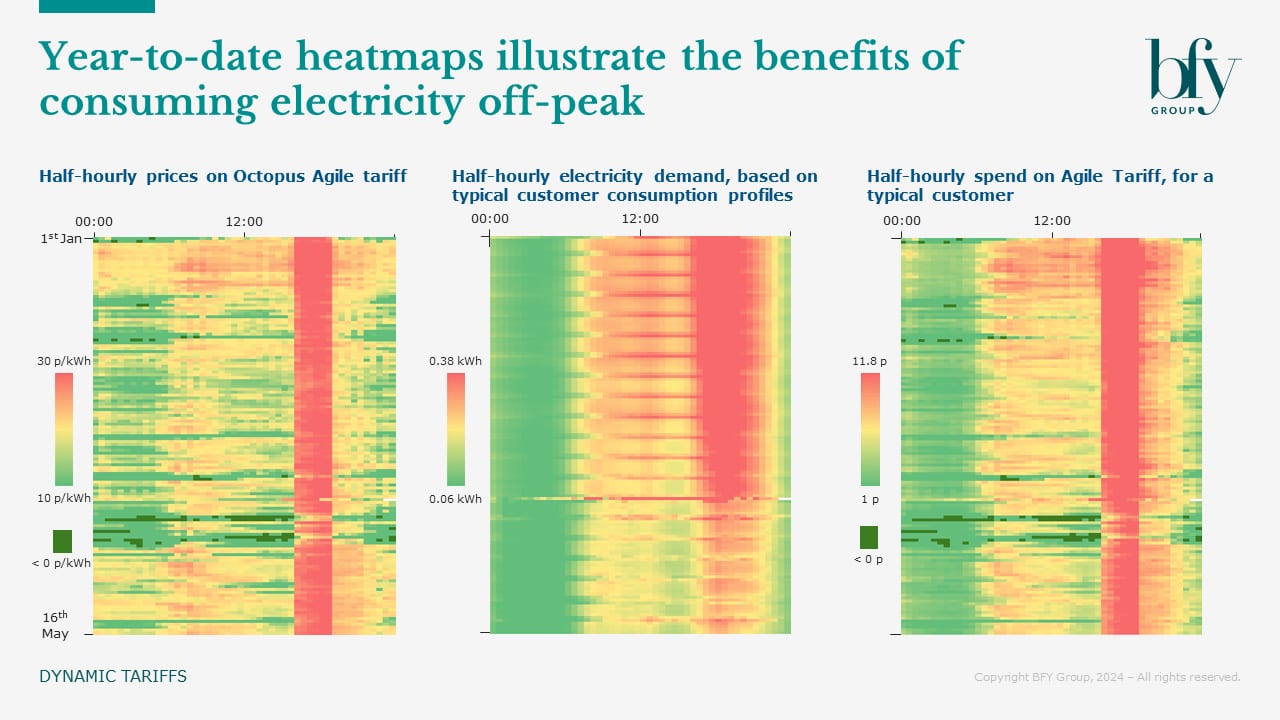The smart meter roll-out was designed to re-engage customers with their energy consumption, helping them to better understand the costs associated with energy usage, and enable a more flexible energy system to support the transition towards net zero.
But, since the onset of the energy crisis, customers have shown a level of disengagement. For many, the IHD (In Home Device) has been put in a drawer, as the initial halo effect of actual readings on bills and seeing daily consumption levels has faded.
As wholesale prices have slowly fallen, more tariff options are emerging in the market. Half-hourly settlements are allowing energy suppliers to take pricing structures one step further than day and night rates, which we already see on EV tariffs.
With more innovative, dynamic price tariffs being introduced, a customer’s primary decision may become less about which energy tariff to choose, and more about when to consume.
Efforts have up until now been focused on installing smart meters in domestic properties, but the focus is likely to shift towards encouraging customers to use smart meters to inform consumption decisions. In light of this, Ofgem is also considering a more dynamic price cap, with time-of-use dependent unit rates to encourage customer flexibility.
More dynamic tariffs on the way, as customers make significant savings
Dynamic pricing allows energy suppliers to charge customers more or less, depending on fluctuations in demand and wholesale price, which is used to incentivise customers to reduce peak-time energy use. Day ahead energy prices, on which dynamic pricing is based, are more liquid and can often be traded at a discount to less liquid forward products, for delivery across the next 12 months.
Communication and marketing by suppliers will be crucial in encouraging large numbers to actively engage with their energy consumption. Octopus is the first supplier to offer half hourly pricing at scale, but we expect more to follow soon, as initial figures show that potential savings are significant.
So far in 2024, a typical customer on the Octopus Agile tariff would have saved ~£100 on electricity consumption compared to the price cap. For most of the day (off-peak), Agile typically offers a £/kWh unit rate around 50% less than the price cap.
On the other hand, during peak hours (usually 16:00-19:30) the Agile unit rate is typically ~33% higher than the price cap. Taking historic half-hourly consumption patterns into account, the weighted average daily unit rate on Agile, across 23/24, was ~25-33% less than the price cap.


As previously discussed in relation to EV tariffs, if customers can shift consumption away from peak hours, dynamic tariffs offer significant savings and can lock-in a unit rate much lower than the price cap.
Why is customer engagement low, and how can suppliers react?
With suppliers being increasingly focused on their ability to influence customer behaviour, it’s important to recognise the potential reasons for low engagement.
A lack of awareness of potential benefits
Are suppliers communicating price fluctuations to customers in a way that’s informative and digestible? Whilst customers may not need to know the exact price of consumption by the half hour, the use of ratios and visualisations could make understanding consumption easier. Consumption profiling will play an important part in educating customers on their energy behaviours and consequential cost.
High upfront cost of smart home equipment
Automated solutions are key to enabling customers to permanently change their behaviour. Without smart home technology, customers may find responding to changing prices too invasive and exhausting, causing response fatigue and leading to only very limited behavioural changes.
The uptake of heat pumps and electric vehicles, which provide considerable shiftable capacity, is likely to influence the number of residential customers who engage with dynamic pricing. The long-term goal for the future of energy will include products that automatically engage with smart time-of-use tariffs, to optimise home energy use without human intervention.
Convenience
Are dynamic pricing tariffs being designed in a way that’s easy-to-use, to make savings feel achievable? It’s important that pricing information is easily accessible and understandable – the use of comparatives and ratios could greatly benefit customer interpretation.
Broadly speaking, on the Octopus Agile tariff, peak times (16:00-19:30) are 2.5x more expensive than off peak (00:00 – 06:00, and 11:00-15:00).
This messaging is more meaningful than specific consumption rates which, for many customers, are hard to translate into actual costs.
Increased exposure to price volatility
With dynamic tariffs that are more closely aligned to wholesale price, comes increased exposure to price volatility. Whilst customers may be able to take advantage of low energy rates during low demand periods, consumption within the peak demand window will likely be at a higher p/kWh than those advertised on the price cap. Although dynamic pricing tariffs include a price cap to provide some comfort, this is significantly higher than the widely advertised price cap on standard variable tariffs.
Potential to shift consumption for prepayment customers and those struggling to pay
Without smart home technology, which is still not commonplace for most, all customers must have the capacity to shift their consumption. Most prepayment customers are acutely aware of their weekly cost of energy. By making consumption patterns clearer to them, through easy access App technology or messages to their mobile devices, we could see a change in usage patterns to assist household expenses.
What’s needed to achieve greater customer clarity?
In light of the above, DESNZ are currently seeking views on standardising smart appliances -with a focus on interoperability, and ensuring they can seamlessly respond to dynamic tariff information from any supplier.
Inevitably, there will be some customers whose energy consumption is more inelastic than others. Customers are unlikely to be able to move toddler teatime, but putting their laundry on a delayed overnight cycle may be feasible. We expect to see market segmentation evolving, with a split between ‘active customers’ who engage with their consumption, and those who favour convenience - meaning their consumptions patterns won’t change.
Although total cost could be significantly lower on a tracker tariff, the price risk shifts to sit with the customer rather than the supplier, which allows energy suppliers to build in a more stable margin. This will be the first stage of a lengthy transition and behavioural shift, which is required to smooth consumption and align with renewable energy production.
Customers have been through a period of price volatility where energy security has been questioned. But to ensure trust continues to be built with suppliers, easy access to simple information should be the baseline for customers, with the purpose of smart meters shifting to enable cheaper prices, rather than limiting supply.
Dynamic value modelling, and real time data elements for customers, should be at the forefront of suppliers’ plans to attract, retain, and support their base.
If you’d like more insight on how you can evolve your value modelling, contact Tom Bromwich.
Matt Turner-Tait
Senior Manager
Matt lead clients through key strategic projects exploring growth opportunities, business models, competitive advantage, and mergers & acquisitions.
View Profile

